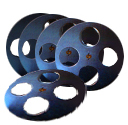|
|
This topic comprises 2 pages: 1 2
|
|
Author
|
Topic: How do I deal with prints that arrive and aren't on reels?
|
|
|
|
|
|
|
|
|
|
|
|
|
|
|
Martin McCaffery
Film God

Posts: 2481
From: Montgomery, AL
Registered: Jun 99
|
 posted 04-27-2006 04:05 PM
posted 04-27-2006 04:05 PM





quote: Georgia Fisher
Recently, a print arrived at our cinema that wasn't on reels, just in plastic containers. I managed to get it put together with some creativity, but was wondering what the proper way is to put it together, and how I'm gonna take it apart? Any ideas? This has never happened to me.
Do you work in an Art House? Your description makes it sound like it arrived without reels or cores. This used to happen frequently when I worked at AFI. Prints from overseas, and sometimes from studio storehouses would arrive on what we called "air cores." Short films, especially from indie filmmakers, usually arrived on cores (and if you ever run dailies in a screening room, they will be on cores).
We always kept a supply of cores on hand and had split reels and flanges to deal with them. There is no kind way I know of of dealing with air cores, you just be as careful as you can. Sometimes the opening will be big enough for a core, other times you go with the flange. Wrapping a piece of scrap film around the flange can help protect the film (which is probably damaged anyway).
On the other hand, if it just came in on cores, yeah, get a split reel.
| IP: Logged
|
|
|
|
|
|
|
|
|
|
|
|
|
|
Stephen Furley
Film God

Posts: 3059
From: Coulsdon, Croydon, England
Registered: May 2002
|
 posted 04-29-2006 02:19 AM
posted 04-29-2006 02:19 AM




Steve, you've mentioned these 9mm cores before; I've never seen one, and I've handled prints from many European countries. I think they must be very much the exception. our prints are normally delivered on normal cores like the ones you use there, with a 1" hole with a keyway. All three sizes of core, 2", 3" and 4" are quite common, but most prints will be on either 3" or 4" cores, or a mixture of the two. Recently, I have seen the cores with the extra holes in them to take the 'snap-together' spools like you have there, but I didn't know what those extra holes were fore until asked about it here. Most of our cores have just the single centre hole, like the ones which raw stock is supplied on.
I have seen two other types of core used for short lengths of film, usually trailers; one is a simple cardboard tube, which can be simply held on a finger while winding the film off it. The inside diameter is slightly more than 2", so if it is necessary to wind the film back onto one of these a standard 2" core, with a few layers of tape wound onto it will be a tight fit inside the cardboard core, and will drive it by friction.
The other type I have seen, and I have only seen one of them, is 1" inside diameter, and only slightly more outside, so it is basically a tube of about 1mm wall thichness, but since it is so thin there is no room for a keyway, so this is reversed, with a ridge in the inside. I've never seen anything that this fits onto, and it hurts, and doesn't wind off evenly, when holding it on a finger.
I have seen a hand rewind bench with 9mm spindles, which had fixed, non-removable, plates on both sides, I couldn't unstand why, but it would make sense for the type of cores which you describe.
John,
in antother thread I wrote, and can't remember how to link to it, the following:
quote: myself
9mm shafts are quite common in mainland Europe, and on machines made there. I haven't seen a Bauer 35mm machine, so I don't know if they are using the standard 9mm ones, or something slightly different.
These are close in size, but not identical, to the 3/8" shafts which are common in Britain; a 3/8 spool will usually fit on a 9mm shaft, but is slightly loose. I've seen both of these sizes with one or two drive pins, (one is more common) but since all the 2k and 6k spools I've seen in these sizes have four holes, it makes no difference. I have seen a few large tower spools for 1/2" shafts, which have only three drive holes, at 120 degrees, and these would obviously not fit on a shaft with two drive pins, which some 1/2" rewinders have.
Kinoton list both American and European 1/2" shafts for their machines; I don't know what the difference is.
I know of at least nine different shaft types on 35mm:
5/16" with key
5/16" with drive pin (rare, only seen it on a few very old machines)
9mm with drive pin
3/8" with drive pin
1/2" with one drive pin
1/2" with two drive pins
With 1/2" the difference does matter, because of the three hole tower spools.
Some machines have their own, non-standard shafts:
Fedi machine with very large spools mounted on the base. about 1"
GBN portable. 1/2" with smaller, closer, drive pin, like 3/8"
BTH Mk.1 SUPA. Weird, never seen anything else like it.
There is also 5/16" with square one end, like 16mm, not normally used for motion picture film, but is used for things like document microfilm,and so might be used on some types of equipment, like a film cleaning machine for example.
One reason I prefer to receive film on cores, at least they seem to be standard worldwide, even the very old wooden ones.
There are some spools which have a removable centre which can be swapped for running on different machines.
Most British cinemas probably couldn't handle a 5/16" American shipping reel, as they don't use anything that size.
We recently received a print late, I was rather alarmed when it arrived it one cardboard box, and two of the American style octagonal transit cases, which are not normally used here. This is far more than should have been needed for the print, which was well under two hours in length. It turned out that the cardboard box contained the print, on cores, in five plastic cans as we would normally receive, and the two American cases contained five empty plastic shipping reels, solid ones not the snap-together type. The print arrived on crossover, and left the same way, so it would seem that it had been to a venue which did not have the means to wind it back onto the 5/16" spools, and so had to send it out on cores, with the empty spools sent sepatately. I do have a 5/16" rewinder, so I sould have put it back onto the spools, but decided that it would be likely to cause problems for the next venue, so I left it as it was. The transit cases had a peculiar locking arrangement, with a small flat metal plate, which had to te threaded through an angled slot in some way, I can't remember the details now. It seemed very clumsy, is this normal on the newer transit cases?
I know of a few British cinemas which use 5/16" spools, including one which uses 6000 foot ones, which seems rather heavy for a spindle this size. I seem to remember that at the National Film Theatre the projectors used something larger, but the magnetic sound followers used 5/16", so different spools would have been needed for each. Do I remember correctly, Leo?
| IP: Logged
|
|
|
|
All times are Central (GMT -6:00)
|
This topic comprises 2 pages: 1 2
|
Powered by Infopop Corporation
UBB.classicTM
6.3.1.2
The Film-Tech Forums are designed for various members related to the cinema industry to express their opinions, viewpoints and testimonials on various products, services and events based upon speculation, personal knowledge and factual information through use, therefore all views represented here allow no liability upon the publishers of this web site and the owners of said views assume no liability for any ill will resulting from these postings. The posts made here are for educational as well as entertainment purposes and as such anyone viewing this portion of the website must accept these views as statements of the author of that opinion
and agrees to release the authors from any and all liability.
|

 Home
Home
 Products
Products
 Store
Store
 Forum
Forum
 Warehouse
Warehouse
 Contact Us
Contact Us




 Printer-friendly view of this topic
Printer-friendly view of this topic






















